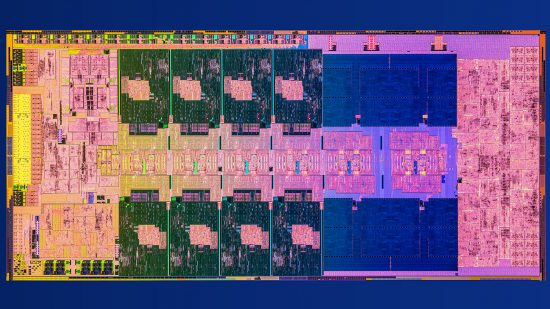The likes of the Intel Core i9-13900K and Core i5-13600K are mighty impressive gaming CPUs but what actually makes them tick? That’s what we’re here to explain in this guide to the inner workings of the Intel Raptor Lake architecture that powers the company’s latest CPUs.
Setting the scene
It’s been a mighty back-and-forth battle between AMD and Intel for CPU supremacy in recent years. AMD’s first Ryzen processors revolutionized the market in terms of value and core count, but struggled when it came to raw clock speed, while Intel offered high clock speeds but relatively few cores.
As the years have gone on, AMD has steadily become more and more competitive on the speed front, while Intel has responded when it comes to core count and value, culminating in AMD comprehensively winning the performance crown with its 5th-generation Ryzen 5000 processors such as the AMD Ryzen 9 5950X, only for Intel to sneak ahead at the end of last year with its 12th-gen Core processors (codenamed Alder Lake) such as the Intel Core i9-12900K.
Recently we saw the tables turn again with AMD’s Ryzen 7000-series processors offering big clock speed boosts over the Ryzen 5000 series, and overall performance that again leapt ahead of Intel. All of which brings us to the launch of the Intel 13th-gen Core processors, codenamed Raptor Lake.
In some ways it’s a relatively modest launch, with Intel not revolutionizing its architecture – as it did with the introduction of E-cores with its 12th-gen products – or shifting to a completely new manufacturing process. For those sorts of changes, you’ll have to wait until next year’s Meteor Lake launch.
However, these 13th-gen chips are still excellent performers with decent bumps in clock speed, an increase in L2 cache and core counts technically increasing by 50 percent thanks to a doubling in the number of E-cores, so there’s plenty to unpack.
The Intel Raptor Lake CPU specs
The full lineup Intel 13th-gen Core processors is extensive but the main retail desktop Intel Raptor Lake CPU specs are:
| Processor Name | P-Cores / Threads | E-Cores | P-Core Boost clock | E-Core Base clock | L2 / L3 Cache | Max boost power |
| Intel Core i9-13900KS | 8/16 | 16 | 5.4GHz (6GHz TVB) | 4.3GHz | 32 / 36MB | 253W |
| Intel Core i9-13900K | 8/16 | 16 | 5.4GHz (5.8GHz TVB) | 4.3GHz | 32 / 26MB | 253W |
| Intel Core i9-13900 | 8/16 | 16 | 5.2GHz (5.6GHz TVB) | 4.2GHz | 32 / 36MB | 253W |
| Intel Core i7-13700K | 8/16 | 8 | 5.1GHz | 4.1GHz | 24 / 30MB | 253W |
| Intel Core i7-13700 | 8/16 | 8 | 5.1GHz | 4.1GHz | 24 / 30MB | 219W |
| Intel Core i5-13600K | 6/12 | 8 | 5.1GHz | 3.9GHz | 20 / 24MB | 181W |
| Intel Core i5-13600 | 6/12 | 8 | 5.0GHz | 3.7GHz | 11.5 / 24MB | 154W |
| Intel Core i5-13400 | 6/12 | 8 | 4.6GHz | 3.3GHz | 9.5 / 20MB | 154W |
| Intel Core i3-13100 | 4/8 | 0 | 4.5GHz | NA | 5 / 12MB | 89W |
TVB = Thermal Velocity Boost
The K suffix denotes that the chips are all multiplier unlocked for easier overclocking. Along with this selection of chips, there are also F variants of most of the above which don’t include integrated graphics, saving you $25 compared to the non-F versions.
Intel Raptor Lake overview
The baseline architecture of Raptor Lake is no different to Alder Lake, with the P-Cores and E-Cores, integrated graphics, and other processor building blocks sporting essentially the same design. As such, to get an understanding of what Raptor Lake brings to the table, we’ll need to look back at what Alder Lake can do.
Starting from the very top, the first factor to note about both Alder and Raptor Lake is that they’re aimed at production on a single piece of silicon, rather than the multiple chiplets used to build up AMD’s latest Ryzen processors.
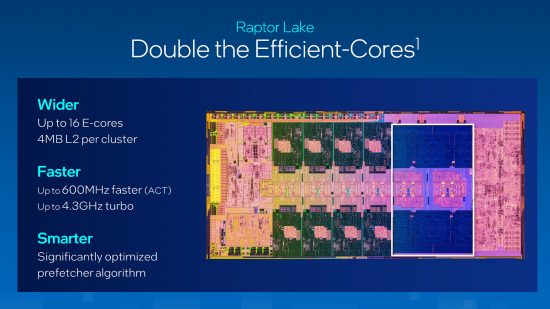
This monolithic approach comes with the advantage of making it easier to interconnect all the components on the chip rather than having to rely on external interconnects between chips. However, it’s a more expensive, riskier approach to produce any one chip than AMD’s approach, as any defects can ruin entire CPUs, rather than just one smaller part of the CPU.
What’s more, you’re forced to use the very latest manufacturing process for the whole CPU, whereas using a chiplet approach allows you to use cheaper, older, or differently-optimized processes for some of the components, such as AMD’s IO die.
It’s for these reasons and more that Intel is set to adopt a chiplet approach for its upcoming Meteor Lake CPUs. That launch is also set to see the debut of the company’s Intel 4 manufacturing process, and will use TSMC’s latest 3nm process to produce the ‘integrated’ graphics chips.
Intel Raptor Lake E-Cores
Getting back to the overall design of Alder Lake and Raptor Lake, the big addition with Alder Lake was the introduction of a power-efficient E-Core (the design for which is codenamed Gracemont) for taking on low-priority background tasks and providing extra parallel processing capability with minimal power consumption.
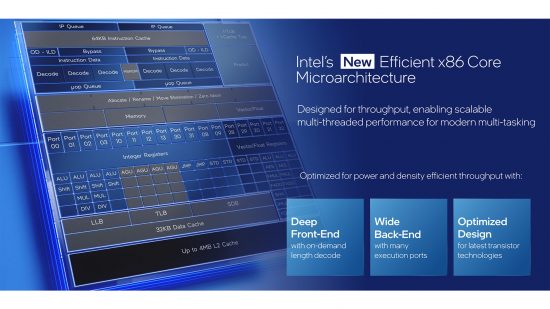
With a design that was top-to-bottom optimized for reduced power consumption rather than peak performance, the E-Cores run slower than the P-Cores and do away with power-hungry elements, such as micro-op caches and support for complex AVX-512 instructions (indeed the E-Cores don’t even support true 256-bit AVX instructions, as these are split into two 128-bit operations).
The upshot of this pared-down approach is a core that not only gently sips power compared to conventional high-performance cores but that takes up far less silicon too. Each cluster of four E-Cores takes up roughly the same die space as a single P-Core.
Intel Raptor Lake P-Cores
As for those P-Cores, they use a core-design codenamed Golden Cove and they’re largely an iteration of the Sunny Cove and Cypress Cove cores used in Intel’s 10th and 11th generation Core processors. That said, Intel did introduce a few tweaks with Golden Cove.
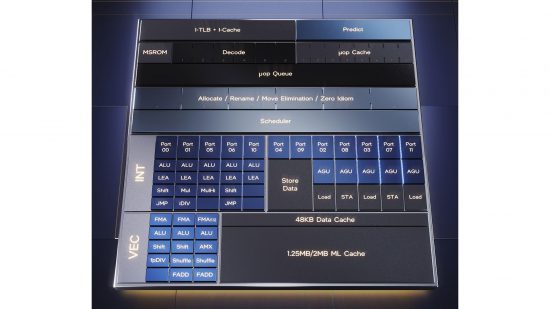
The front end uses a 50 percent wider micro-op decoder and a micro-op cache that’s nearly twice as large as that on the older Cypress Cove design. Other optimizations included doubling the translation lookaside buffer, a larger micro-op queue and a more than doubling of the branch target buffer (BTB).
The front end of a processor core is all about decoding large instructions into smaller micro-ops that are passed to the processor, optimizing the order in which instructions are executed and predicting the outcome of branches in code. As such, the larger micro-op decoder, micro-op caches and BTB ensure the CPU can keep as many potential pieces of work in flight as possible. This keeps the execution engine portion of the chip – where those micro-operations are performed – fed with work as efficiently as possible.
Then we come to the execution engine, where Intel has slightly increased the number of execution ports, from 10 to 12, and significantly increased the reorder buffer (ROB – used to store the outcome of instructions for use by other instructions) from 352 entries in Cypress Cove to 512 entries in Golden Cove. This compares to just a 256-entry ROB in the E-Cores and a 320-entry ROB for AMD’s latest Zen 4 architecture.
The execution ports themselves use a fused arrangement where both floating point and integer operations are performed by several of the ports, allowing the scheduler to dynamically optimize which operations to perform on which ports. This is in contrast to AMD’s latest Ryzen architectures, which use a separate arrangement of integer and floating point ports with separate schedulers.
A notable change from Intel’s previous architectures is that, while the execution engine of Alder Lake and Raptor Lake’s P-Cores is able to process 512-bit AVX instructions, Intel has actually disabled this feature in both architectures.
This is because the E-Cores don’t support the feature and it has proved troublesome to manage how the Thread Director (the onboard microcontroller that monitors thread load and communicates thread priorities to Windows) deals with these instructions. Ironically, AMD has in the meantime only just got round to adding decent support for these instructions in its latest CPUs.
Also new to Alder Lake was the introduction of dedicated matrix multiplication hardware, akin to the Tensor cores on Nvidia’s GPUs. These advanced matrix extension (AMX) components are also present on Intel’s new Intel Arc graphics cards. Such hardware is seen as key for future applications, as machine learning relies heavily on matrix multiplication.
The upshot of these P-Core changes was an average 19 percent uplift in instructions per clock compared to Cypress Cove chips, while the E-Cores delivered Intel Skylake (Intel’s 6th-gen Core processor design) levels of performance while using 40 percent less power.
Alder Lake also saw the introduction of support for DDR5 memory, while maintaining DDR4 support, plus the use of an integrated graphics module based on the company’s Xe (Gen12) graphics architecture. The Z690 chipset was also introduced, with support for 20 PCIe 5 lanes and the new LGA1700 socket that the new CPUs would use. Raptor Lake retains most of these features, although it does introduce a new chipset, which we’ll discuss more in a moment.
Intel Alder Lake to Raptor Lake changes
Having established the baseline architecture of Alder Lake, we can now explore more deeply the changes made for Raptor Lake, which although not numerous do add up to significant performance gains across the board.
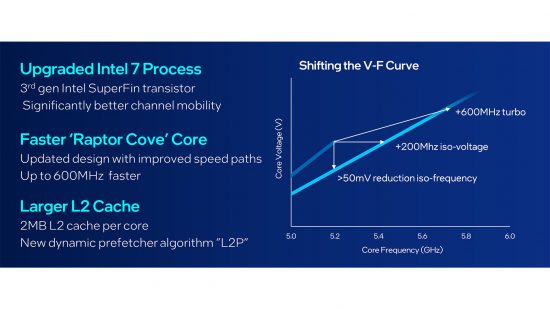
For a start, these 13th-gen chips are using the latest iteration of the Intel 7 manufacturing process. Improvements to the channel mobility – the rate of electron flow through the transistor’s gate – have allowed for higher clock frequencies at reduced voltages, opening up these chips to run up to 600MHz faster than their predecessors.
Despite these gains, we’re not seeing a revolution in power efficiency or in maximum power consumption. As Intel’s turbo max power figures and our own tests show, these chips still consume a significant amount of power (and have a resultant high heat output) when under full load. AMD’s latest chips also demand top-notch cooling and a quality power supply, but the likes of the Core i9-13900K push the envelope even further.
If power consumption and long-term usability aren’t a concern though, Intel is making some bold claims about the overclocking headroom of these chips. With extreme cryogenic cooling Intel expects frequencies over 8GHz to be possible. With conventional cooling the story isn’t quite so dramatic. We saw good results with the slower-clocked Core i5-13600K but there’s not a lot of headroom for the higher-end processors such as the Core i9-13900K.
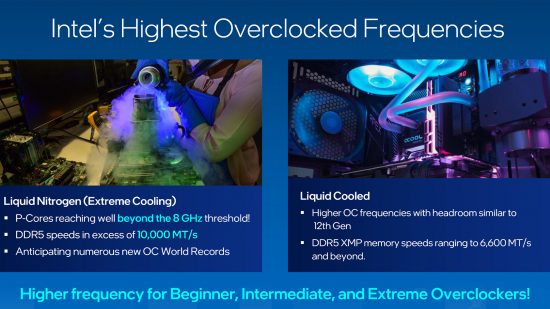
When it comes to E-Core clock speeds, Raptor Lake brings with it up to a 600MHz increase in all-core turbo (ACT) speed over 12th-gen chips, while single-core turbo speeds max out at 4.3GHz, compared to the 3.9GHz on its 12th-gen chips.
Another key change from Alder Lake to Raptor Lake is an increase in L2 cache size. The P-Cores now have 2MB each, up from 1,280KB. Meanwhile, the E-Cores retain their 4MB of L2 cache per cluster of four E-Cores, giving the Core i9-13900K a total of 32MB of L2 cache.
That’s double the amount of L2 cache AMD includes in its Ryzen 9 7950X – despite AMD doubling the size of its L2 caches when moving from Zen 3 to Zen 4 – but again the P-Core/E-Core situation means it’s not overly meaningful to compare total L2 cache amounts.
Meanwhile, when it comes to L3 cache, or last level cache (LLC) as Intel calls it, the Core i9-13900K packs in 36MB. This is far less than the Ryzen 9 7950X’s 64MB, which continues a trend we’ve seen for a while, with AMD’s architecture relying heavily on large L3 caches. The Ryzen 7 5800X3D remains blistering fast in games, for example, thanks to its extra slab of L3 cache stacked right on top of the CPU.
Continuing the theme of using generally faster and larger components in Raptor Lake, the compute fabric that runs down the middle of the processor and manages communication between the cores and caches has seen its maximum clock speed bumped to 5GHz, up from 4.7GHz, while its ACT speed is up to 900MHz faster. Although this won’t directly increase performance in and of itself, it will ensure the faster-running cores aren’t starved of the data they need.
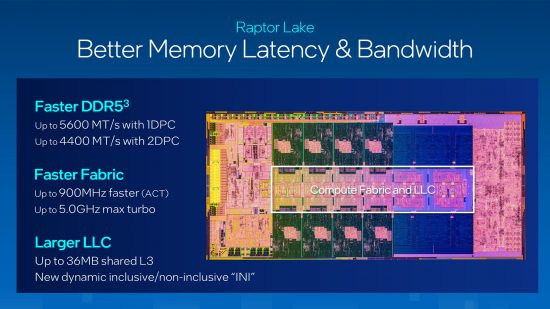
This internal speed increase is matched by support for faster DDR5 memory. While Alder Lake officially topped out at 4,800MT/sec memory for one DIMM per channel (1DPC) and 4000MT/sec for 2DPC, Raptor Lake pushes this to 5,600MT/sec and 4,400MT/sec respectively. In contrast to most of AMD’s Ryzen generations, Intel’s recent architectures haven’t been overly reliant on high memory speed for optimal performance, but the extra headroom certainly can’t hurt.
The final publicly stated tweak Intel has made to transform Alder Lake into Raptor Lake is to change its prefetcher algorithm. This deals with prefetching instructions or data from memory or slower cache stores and moving them to faster caches, ready to be next in the operation queue.
Intel Raptor Lake performance
The net result of all these changes is a claimed 15 percent increase in single-threaded performance when comparing the Core i9-12900K to the Core i9-13900K, according to Intel’s figures. Roughly 70 percent of this improvement comes from the increased frequency, with around 15 per cent each of the remaining increase coming from the faster memory and caches.
Notably, none of the performance increase is attributed to an improvement in instructions per clock (IPC), as you’d expect given the lack of architectural changes. This contrasts with the introduction of Alder Lake, which brought with it a 19 percent IPC increase over Rocket Lake and AMD’s Zen 4, which introduced several architectural changes that amounted to a 13 percent improvement in IPC over Zen 3.
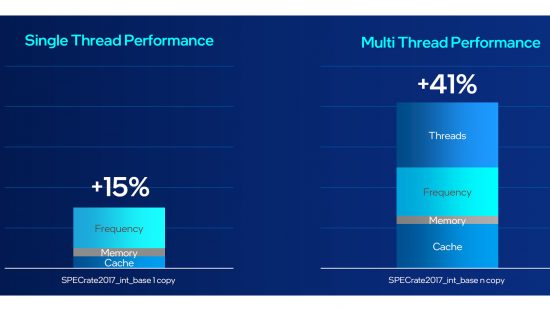
Regardless of the lineage of the performance uplift, the net result is evidenced in our testing with the Core i9-13900K significantly outstripping the Core i9-12900K in single-threaded applications. It even beats the Ryzen 9 7950X in some scenarios here too, though it isn’t a clean sweep. Meanwhile, the Core i5-13600K comfortably beats its predecessor but falls behind the AMD competition until overclocked.
As for multi-threaded performance, here Intel claims a 41 percent increase due in large part to those extra E-cores. This is again a claim we saw borne out in our testing, with a big improvement when going from the Core i9-12900K to the Core i9-13900K, though ultimately multi-threaded performance was on par with the 16-core Ryzen 9 7950X.
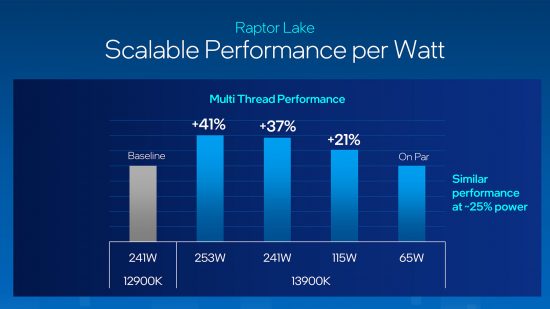
Frequency is the next largest factor for improved multi-threaded performance, while the cache changes also make up a significant chunk, which shows the importance of having large and fast enough data structures to efficiently move data around these many-cored processors.
While instructions per clock may not have improved with Raptor Lake, the other tweaks do provide an improvement in performance per watt. Although total power consumption under load has increased when going from the Core i9-12900K to the Core i9-13900K, you’re getting a 41 percent increase in multi-threaded performance for just a 5 percent increase in power consumption.
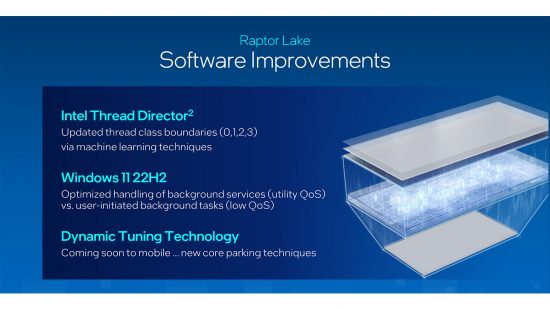
As well as hardware improvements, Intel has also been working hard on improving its Thread Director system. Using machine learning, Intel has calculated new boundaries for each class of thread, making the Thread Director better at knowing which threads are the best ones to send to a P-Core for speedy processing and which can chunter along on E-Cores. Thread prioritization has also been made faster and more efficient in Windows 11’s 22H2 update.
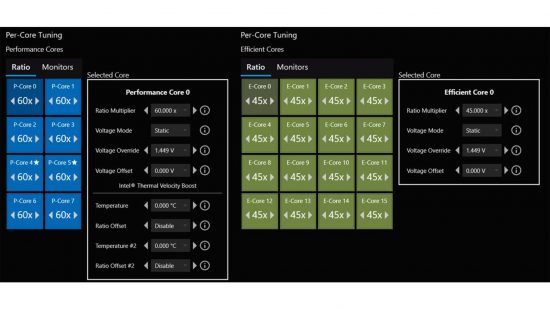
In addition, overclocking has been made easier thanks to improvements to Intel’s Extreme Tuning Utility (XTU). There’s now a one-clock Speed Optimizer feature with a compact view, or if you want to get more granular you can now tune on a per-core basis for both P-Cores and E-Cores separately.
Z790, Raptor Lake memory, and software improvements
Raptor Lake is launched alongside a new motherboard chipset, Z790, but the CPUs use the same LGA1700 socket as Alder Lake. This opens up the possibility of using older Z690 and B660 motherboards – even those running DDR4 memory – with the new CPUs, but this will depend on BIOS updates for the older boards.
Assuming your board is compatible, this makes for a surprise upgrade victory for Intel. Not only do you get an easy path to slotting in a faster CPU if you already have a Z690 or B660 motherboard, but you can also hold onto your old DDR4 RAM if you’re looking to buy a new CPU and motherboard.
There are also a few Z790 motherboards that support DDR4 memory, such as the ASRock Z790 PG Lightning D4, but if you want to save some cash you could buy an older Z690 board at a cut-down price, keep your existing DDR4 memory, and slot in a brand new CPU. In contrast, AMD’s newest CPUs use a new socket and only support DDR5, compelling you to invest in new memory and a new motherboard all at once, if you’re upgrading from an older AM4 AMD platform – that’s a lot of money at today’s prices.
This upgrade path is all the more tempting as Z790 doesn’t include a great deal when it comes to extra features. You get four extra PCI-E 4 lanes and one extra 20Gbps USB 3.2 2×2 port and that’s your lot. Check out our best Z790 motherboards list for our current top picks.
The wrap up
All told, while Raptor Lake may not be the most exciting CPU launch when it comes to big headline numbers, in actuality, it has proven to be quite compelling. Increases in overall core count significantly boost multi-threaded performance where needed, while up to eight P-Cores is ultimately sufficient for the vast majority of uses, and is certainly enough for gaming.
Power consumption remains high, but overclocking of the Core i5-13600K in particular is very impressive, opening up the option of buying a cheap processor and getting big performance gains by cranking up those voltages. Considering how little overclocking headroom we’ve tended to see in recent CPUs, it’s great to see a return of proper manual overclocking wins.
Add in the backwards compatibility options available, thanks to the continued use of the LGA1700 socket and support for both DDR4 and DDR5 memory, and Raptor Lake becomes a very tempting proposition, especially given the relatively competitive prices.
Have you upgraded to an Intel Raptor Lake CPU? If so what has your experience been? Let us know your thoughts on the Custom PC Facebook page, via Twitter, or join our Custom PC and Gaming Setup Facebook group and tap into the knowledge of our 375,000+ members. Meanwhile, check our out best CPU for gaming guide to see which CPUs we recommend right now whatever your budget.
